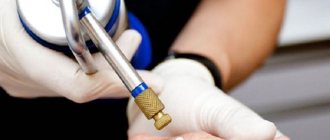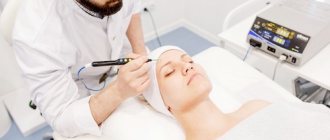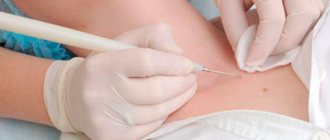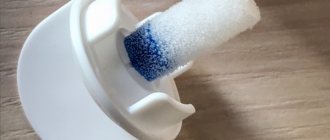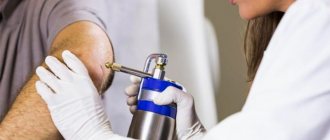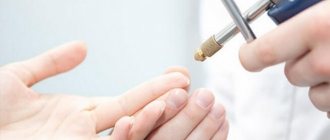Author
Kulova Zhanna Borisovna
Head of the Center for Cosmetology and Preventive Medicine
Cosmetologist
until January 31
You get 10% cashback when purchasing a gift certificate More details All promotions
Cryodestruction is a method of removing tumors on the skin, which is based on the use of liquid nitrogen. Often considered as a tool in aesthetic cosmetology and dermatology, allowing you to get rid of:
- warts;
- papillomas;
- condylomas;
- keratome;
- hemangiomas;
- unwanted moles (nevi).
This method is successfully used in other branches of medicine - gynecology, surgery, oncology. The method of cryodestruction successfully removes tonsils and treats cervical erosion. Using endoscopic methods, doctors have learned to use cryodestruction to combat tumors of internal organs.
Removal of tumors with liquid nitrogen: main advantages
The main advantage of this method is its low invasiveness. After the destruction of the tumor, a crust forms on the skin, under which the healing process is actively underway. Soon the crust falls off, leaving no trace. There is practically no bleeding or pain during this procedure; there is no need for special preparation or anesthesia.
The benefits of using liquid nitrogen include:
- rapidity;
- short recovery period;
- no need for special care of the treated skin area;
- affordable prices for cryodestruction procedures.
It is also important that various moles, papillomas or warts, regardless of their nature, can be treated equally effectively. Therefore, if you decide to remove a skin tumor by cryodestruction, you can count on a positive result after the first session.
How to treat a wart after cauterization
Proper treatment of warts after cauterization with nitrogen helps prevent the possibility of bacterial infection and speed up the healing process.
Therapeutic treatment involves the use of special antibacterial agents. They should be used until young skin appears on the wound surface. The most effective means include:
- Fukortsin is an antiseptic solution that has a pronounced antimicrobial effect. It has a bright crimson color. Treatment is carried out 1-3 times a day. Suitable for children under 12 years of age.
- Baneocin is a combined antibacterial drug. Available in powder and ointment form for local treatment. Treatment is carried out 2-4 times a day, depending on the type and scale of the lesion.
- Chlorhexidine is a solution for external treatment of wounds. Actively used in gynecology. It has an antimicrobial effect after removing the wart with nitrogen and prevents the onset of inflammatory processes. Not used in pediatrics.
- Levomekol is an ointment for treating wound surfaces after removal. The ointment contains antibiotics that suppress bacterial flora. The components of the drug enhance regenerative processes.
- Salicylic ointment has anti-inflammatory, keratolytic, antiseptic effects. It is used for treatment when the wound becomes covered with a bubble after cryodestruction. You need to smear it once every 2 days.
- Iodine is a solution intended for antiseptic treatment of wounds after removal of warts with nitrogen. The painful area is lubricated around the circumference, avoiding the solution getting into the wound itself. It is permissible to carry out treatment 2-3 times a day.
- Potassium permanganate – powder for preparing solutions. Potassium permanganate is diluted with boiled water. The solution should acquire a pale pink color; wiping off the wound surface is allowed. If the growth is located on the fingers or feet, you can make baths with potassium permanganate.
When the wound begins to heal, Contractubex (sometimes hormonal drugs) or Panavir are used to prevent scarring. The latter, in addition to its healing properties, has the ability to suppress HPV activity and restore the protective functions of the immune system.
How is papillomas removed by cryodestruction?
A few seconds of exposure to liquid nitrogen is enough for the neoplasm to collapse
Using the example of papilloma, we will look at how the procedure for removing a tumor with liquid nitrogen is carried out. The process can be divided into the following stages:
1. Freezing papilloma. Using a special device or miniature applicator, the doctor applies liquid nitrogen with a temperature of –195.7 degrees Celsius to the tumor.
2. Necrosis of papilloma. Under the influence of liquid nitrogen, the pathological area turns pale, the patient begins to feel a slight tingling: this is the crystallization of the cytoplasm in the neoplasm cells, which damages their membranes. The time allotted for the procedure (from 5 to 30 seconds) is quite enough to cause irreparable damage to the papilloma.
3. Restoration of blood circulation. Within a few hours after the procedure, the area of skin where the papilloma was located turns red and swells.
4. Complete necrosis of papilloma. The process takes from 2 weeks to 2 months. From the neoplasm itself, only a crust remains, and healthy, smooth tissue forms under it.
5. Recovery. After a maximum of six months, there will be no traces left on the skin.
If the papilloma was large enough, the procedure may need to be repeated. In this case, only a doctor can give the exact timing of the final solution to the problem.
If after cryotherapy a bubble with liquid appears at the site of the tumor, it is not recommended to pierce it. It is better to treat the skin area with an antiseptic until this bubble disappears naturally, or consult a dermatologist for advice.
Rules for caring for a wound after cauterization
Rehabilitation is no less important stage of treatment than removal.
In order for the restoration of the skin to be successful, without negative consequences and complications, it is necessary to follow the rules of wound care:
- It is forbidden to wet the wound. It is not recommended to take a bath for the first 3 days after surgery.
- After starting water procedures, cover the wound with a plaster to prevent water from entering. After bathing, gently wipe the affected area with a paper towel. It is unacceptable to rub with a towel.
- Change dressing materials regularly. During treatment, use antiseptic agents to prevent dirt from entering the open wound after removal with nitrogen and blood.
- Do not touch the affected area unless necessary. This can injure the area, causing inflammation and prolonged healing.
- It is forbidden to try to cut or pick off a wart. This can lead to the development of complications, which is dangerous in the matter of wound healing and for human health.
- It is necessary to protect the growth from direct sunlight. This includes limiting your time on the beach or visiting the solarium.
- It is forbidden to pierce a bubble with liquid. Under the thin film of the blister there are ideal conditions for the growth of bacteria.
- The crust that appears after the bubble bursts is not peeled off. Otherwise, the risk of scarring or scarring increases.
- It is not recommended to use decorative cosmetics if the growth is on the face. You should avoid using aggressive hygiene products (belongings, masks).
- If the wart is located on the foot, you should limit wearing shoes. For heel wounds, you will have to give up heels and uncomfortable platforms for several months.
- Treatment after removal with nitrogen should be carried out only with products prescribed by the attending physician.
Compliance with all the rules for caring for a wart will help shorten the rehabilitation period. The growth dies off within 2 weeks. During normal healing, after nitrogen removal, the skin will be completely cleared within 1 month.
Indications and contraindications for cryodestruction
As a rule, patients decide to remove skin tumors wanting to get rid of cosmetic defects. First of all, it is recommended to remove moles and warts located in “unsuccessful” areas where they are regularly injured.
There are practically no contraindications to cryotherapy: it is recommended even for children, if necessary. But there are cases when it does not give the desired effect, for example, if the diameter of the tumor exceeds 4 mm.
It is better to refrain from cryodestruction during infectious and inflammatory processes until they are cured.
Make an appointment Do not self-medicate. Contact our specialists who will correctly diagnose and prescribe treatment.
Causes of warts
Prerequisites for the formation of warts:
- neglect of personal hygiene rules (using someone else's shoes, washcloths, towels, manicure and pedicure instruments);
- increased skin moisture, especially hyperhidrosis of the feet and hands;
- immunodeficiency states of the body (HIV infection, cancer, treatment with cytostatics, viral hepatitis B and C);
- chronic stress;
- chronic dermatoses requiring treatment with external hormonal agents (atopic dermatitis, psoriasis, eczema and other itchy dermatoses);
- metabolic disorders in the body and hormonal dysfunctions.
Warts also often appear on thin baby skin.
Cost of cryodestruction of tumors
| Cryomassage and cryodestruction of benign neoplasms |
| Service code | Service name | Number of services | Price |
| A24.01.004.001 | Cryodestruction of skin: removal of papillomas, keratomas, warts, condylomas (up to 0.5 cm 1 element) Code: A24.01.004.001 | 1 | 500 ₽ |
| A24.01.004.002 | Cryodestruction of the skin: removal of papillomas, keratomas, warts, condylomas (0.5 - 1.0 cm. 1 element) Code: A24.01.004.002 | 1 | 1 000 ₽ |
| A24.01.004.003 | Cryodestruction of the skin: removal of papillomas, keratomas, warts, condylomas (more than 1.0 cm, 1 element) Code: A24.01.004.003 | 1 | 1 500 ₽ |
| A24.01.005 | Skin cryomassage (1 zone, 1 procedure) Code: A24.01.005 | 1 | 800 ₽ |
Radio wave removal of warts
The technology gives the surgeon the opportunity to cut out the tumor literally “at the root.” It is used to remove the following types of warts:
- flat,
- plantar,
- speakers.
- hanging.
In addition, the method is suitable for removing genital warts. The procedure itself takes 10-20 minutes and is almost bloodless. To numb the area being treated, the doctor uses local injection anesthesia or a superficial application of a special cream. To remove the growth, a specialized device is used - Surgitron, also known as a radio knife. It has a gentle effect on the problem area of the skin without affecting healthy tissue, without irritating nerves or causing muscle contractions.
The main advantage of the radio wave method is minimal trauma, since radio waves practically do not affect surrounding tissues. The risk of inflammation and complications is also minimal.
Burning out formation
There are several methods for removing spines using liquid nitrogen:
- reed method;
- open spray;
- probe;
The reed method is the simplest and is often used in cryotherapy. The liquid substance is applied to the surface of the spine with a wooden stick and cotton wool. An open spray is suitable for large lesions and allows nitrogen to be sprayed evenly over the affected area.
Probe – for removing small and deep-lying formations.
The choice of method for supplying liquid refrigerant is decided by the dermatologist, based on the location, size, and depth of distribution of the spine.
Preparing for the procedure and is it painful?
No special preparation is required before removing the spine. Before the procedure, you need to consult a specialist, make sure the formation is benign, and confirm the diagnosis. Then the nitrogen destruction method is determined. The reed or open spray method is more often used.
Need advice from an experienced doctor?
Get a doctor's consultation online. Ask your question right now.
Ask a free question
Having determined the technique, the spine and the skin around it are treated with liquid antiseptics. For this, use Chlorhexidine or Betadine.
After several treatments with nitrogen, anesthesia is given before removal, which is selected according to the patient’s pain threshold and the stage of wart growth.
In case of severe pain, the spine is injected with Novocaine or other local anesthetic. The growths on the heels are especially painful.
Freezing
A stick with cotton wool at the end is dipped into a container with nitrogen. Then immediately press the spine to the surface. The liquid form of the substance, having a temperature of -196° Celsius, freezes the tissue of the plantar wart instantly.
Exposure time is from 10 to 40 seconds, depending on the size of the formation and the depth of the lesion. Considering the benign nature of the growth, they try to minimize the time of freezing with liquid nitrogen; only cells localized in the epidermis need to be removed.
After the first pressing, the surface of the spine turns pale, thickens, frost appears, which disappears as it thaws. The time allotted for thawing is 2-3 times longer than for freezing.
During one procedure, 2 to 5 nitrogen applications are performed. At the end of the session, the site of cauterization of the spines is treated with a liquid antiseptic and covered with a bandage.
Wart removal occurs by the following mechanisms:
- the destructive effect of nitrogen due to the formation of ice crystals in cellular elements;
- during thawing, the concentration of ions in the spine cells increases and the electrolyte balance is disturbed;
- Liquid freezing causes temporary spasm of blood vessels and impaired microcirculation.
Wound care
After cauterization with nitrogen, the spine swells and turns red. Then a bubble appears with liquid serous or hemorrhagic contents. This is a normal skin reaction to extremely low temperatures. A hyperemic rim may appear around the vesicle, which soon disappears. At this moment, necrosis of the wart begins to develop.
Pain syndrome after removal with nitrogen is insignificant. Painkillers are not prescribed. Within two weeks after cauterizing the spine with a liquid substance, the bubble will subside. Then the vesicle cover should turn black and turn into a scab.
Regeneration of the epithelium will occur within 4-6 weeks, depending on wound care. While healing, the wound may itch. You should not comb it, this can lead to secondary infection of the wound and complications.
Wound care after wart removal with liquid nitrogen:
- maintaining foot hygiene;
- providing rest to the leg where the spine was located;
- daily treatment with antiseptics - Panthenol, Chlorhexidine, peroxide;
- Do not apply creams or other skin care products to the wound surface;
- You can use keratoplastic medicinal substances after the formation of a scab - Solcoseryl, zinc ointment, salicylic ointment.
During the recovery period, it is prohibited to independently remove crusts, open blisters with liquid contents, scratch the wound, overheat, or hypothermia of the leg. The consequences of non-compliance with the rules are the formation of a scar, hyperpigmented or hypopigmented spot in the place of the spine eliminated with nitrogen.
Failure to maintain personal hygiene can lead to bacterial infection after removal with nitrogen. As a result, a clinic of inflammation is observed. A bursting or pulsating pain will appear. It will gradually increase until it becomes so pronounced that it will be impossible to lean on the leg. Hyperemia and swelling will increase around the wound. Soon the damage will begin to fester. If the accumulation of pus is superficial, the pus is likely to break out. In response to inflammation, the temperature of the body and the damaged area will increase.
In this case, you need to urgently consult a doctor. He will prescribe antibacterial therapy after using nitrogen, and will debride the wound after removing the spine with a liquid chemical. You should not try to remove pus at home.
Removal of spines in Krasnoyarsk
Effective removal of spines in Krasnoyarsk is offered by the OK Laser Cosmetology Center.
The Center’s specialists are required to conduct a preliminary consultation and diagnosis with a dermatoscope in order to determine the nature of the tumor and the possibility of its safe removal.
The removal of spines is carried out in the following ways:
- cryodestruction (removal of the spine with nitrogen);
- plasters and ointments with a keratolytic effect followed by grinding with a milling cutter;
- laser treatment (the most modern and effective method);
- immunocorrective therapy - the introduction of antiviral homeopathic drugs directly under the spine with a thin needle or intramuscularly.
As already mentioned, the most modern (effective, fast and safe) method is laser treatment of spines .
What are the dangers of removing spines on your own?
Getting rid of spines using “folk” methods is not only ineffective, but also unsafe.
Firstly, this can lead to an inflammatory process and the addition of a secondary infection.
Secondly, this is fraught with complications such as burns.
Thirdly, this leads to a decrease in local immunity , thereby increasing the risk of the proliferation of maternal spines and the appearance of new daughter spines. And this, in turn, leads to temporary disability.
Surgical removal of warts
Plantar warts are most often removed surgically. As a rule, they are a benign neoplasm, saturated with blood vessels. In its structure, such a growth usually resembles cauliflower. Sometimes it can grow into the skin, causing pain when walking and rubbing against shoes. Plantar warts most often become a source of spread of the human papillomavirus.
The surgical method is used only if conservative therapy is ineffective. First, the doctor takes a test for histology and gives a tetanus vaccination. The operation itself includes the following steps:
- Treating the sole with soapy water.
- Separation of the hyperkeratosis covering the wart in order to determine its contours.
- Skin treatment with povidone-iodine.
- Local anesthesia with mepivacaine (2%) or another drug without the use of vasoconstrictors.
- Light massage with gauze to quickly spread the anesthetic.
- A skin incision and complete excision of the pathological growth.
- Cleaning the cut area using a Jansen spoon.
- After stopping the bleeding, clean the wound with saline solution.
- Treatment of the area with povidone-iodine, followed by application of a bandage.
After the procedure, the patient should try to keep the operated limb in an elevated position. Relative rest is recommended for 48 hours after surgery. During this time, it is necessary to avoid open sources of heat and, if necessary, take painkillers.
After 48 hours, the first dressing is done, during which the dried blood is removed with a scalpel, and the wound is washed with saline solution under pressure. After this, an enzymatic ointment is applied to the treated area, which is covered with polyethylene on top. Using shoes with an orthopedic insole, the patient can already lean slightly on the operated leg.
